For decades, the history of the ‘Bennett, Reifenberg, Brooks’ eluded scholars even as its stories were hidden in plain sight. In this week’s carteggio, Jason Price and Michael A. Baumgartner unwrap the mysteries of this striking violin by Carlo Bergonzi.
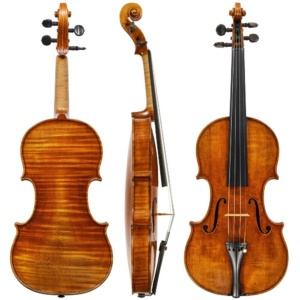
The ‘Bennett, Reifenberg, Brooks’ Bergonzi.
Alfred Hill first encountered this Bergonzi violin in Paris in the early 1880s at the shop of the violin maker and dealer, Emile Germain (1853-c. 1933). Hill wrote to his brother Arthur back in London and described the violin but the Hill brothers wouldn’t see this Bergonzi again for over a decade.
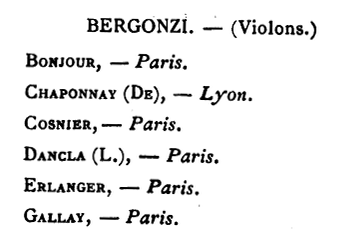
Jules Gallay, the French music historian, knew of fifteen Bergonzi violins by 1872[1] and very few of these have been reliably associated with instruments known to us today. It’s likely that the ‘Bennett, Reifenberg, Brooks’ was one of the instruments that Gallay cataloged, but it’s not possible to say for sure. Perhaps it was the violin in the possession of Léopold Dancla (1822-1895), the violinist and composer. Léopold and his brother, the more famous violinist Charles Dancla, dealt often with Emile Germain. Léopold retired in 1881 so it’s possible that this was his Bergonzi. It is, however, equally possible that we’ll never know definitively where the ‘Bennet, Reifenberg, Brooks’ was before Alfred Hill first saw it in the shop of Germain in c. 1882.
In 1883 the Glasgow dealer David Laurie (1833-1897) bought the violin from Germain and brought it to England where he sold it to Richard Bennett (1849-1930) through Siegfried Jacoby, (1836-1913) the violinist who was advising Bennett on violin purchases at the time. Bennett, who the Hills affectionately referred to as a “cotton-spinner”, was the owner of the Bleachers corporation, a chemical and textile bleaching company in Great Lever, near Bolton in Lancashire. In the early 1880s Bennett had begun to acquire instruments using Jacoby as his guide. Over the course of five decades Bennett would come to own almost every great Stradivari or Guarneri violin, holding some for many years while buying and selling others at whim. Other instruments which formed part of the Bennett collection include the 1716 ‘Messiah’, the 1721 ‘Lady Blunt’, the 1714 ‘Dolphin’, the 1690 ‘Tuscan’, the 1719 ‘MacDonald’ viola, the 1715 ‘Alard’, the 1716 ‘Cessole’, the 1744 ‘Leduc’, 1735 ‘Plowden’, 1744 ‘Sainton’, 1734 ‘du Diable’, 1741 ‘Kochánski’ and the 1742 ‘Lord Wilton’.[2] In addition to his interest in violins, Bennett was also an important collector of early books and manuscripts. In 1902 Bennett’s collection of illuminated manuscripts and incunabula was sold to J. Pierpont Morgan for £140,000[3] and in 1911 Bennett’s collection of Chinese porcelain was sold to the Lancashire soap magnate William Hesketh Lever the 1st Viscount Leverhulme (1851-1925) for £275,000.[4] Both sums would have dwarfed Bennett’s investments in violins.[5]
Inexplicably, previous scholarship failed to correctly identify Richard Bennett as the owner of this violin. An article in the August 1961 issue of The Strad magazine misstated his name as “Packland Bennett”.[6] Fifty years later this error was repeated in the catalog published in conjunction with the 2010 Bergonzi exhibition in Cremona. Nevertheless, original documents preserved with the violin, the W. E. Hill & Sons Business Records, the Hill Diaries as well as other archival sources confirm he was indeed Richard Bennett at the address of Lever Hall, Bolton.
Inexplicably, previous scholarship failed to correctly identify Richard Bennett as the owner of this violin
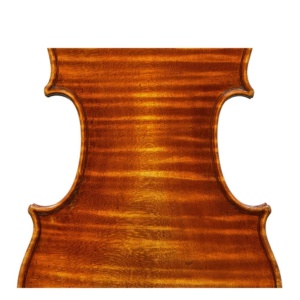
Over the course of five decades Richard Bennett would come to own almost every great Stradivari or Guarneri violin.
In 1889 Bennett traded this Bergonzi to Frederick Smith (c1849-1914), a manufacturer of metal wire from Yorkshire who dabbled in violin collecting and dealing. Smith was a friend and frequent client of the Hill brothers, owning at least seven Stradivari and numerous other fine instruments. In 1911 the Hills introduced Smith to the British portrait painter and illustrator Sydney Seymour Lucas so that Smith could commission a large-scale painting of Stradivari in his workshop.
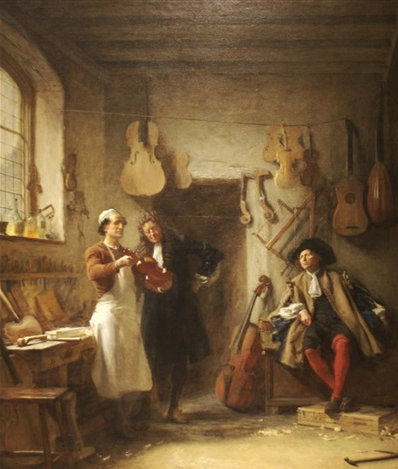
The Violin Maker (1913) by the British portrait painter and illustrator Sydney Seymour Lucas. Arthur Hill introduced Frederick Smith to Lucas in 1911 and Smith commissioned this large-scale painting of Stradivari in his workshop. According to Arthur Hill, the painting was to depict when Marquis Ariberti visited the Stradivari workshop to commission instruments for the Grand Duke of Tuscany. The price was £400 plus an additional £100 for the copyrights.
Two or three years after Smith acquired the Bergonzi, he sold it through Alfred W. Gilmer (1838-1892), an obscure wind instrument dealer in Birmingham. In January of 1892, just four months before Gilmer passed away, the violin was sold to Thomas Oddie[7] of Leamington Spa.[8] Two not insubstantial disputes followed: firstly, Gilmer had charged Oddie £500 for the violin, a monumental and unprecedented price for a Bergonzi at the time, but it emerged later that he, or rather his son, Charles W. Gilmer, had only paid Smith £300. The second problem was that Gilmer and Smith (and Laurie as well it seems) sold the violin as entirely original, including the scroll. When Oddie brought the violin to W. E. Hill & Sons for advice in 1895 they made a point of noting that fifteen years ago in the letter that Alfred Hill had written to his brother after seeing the violin in the shop of Germain, he had noted that the head was not original. Perhaps relieved to have found an honest broker in the Hills, Oddie entrusted the Bergonzi to them shortly thereafter.
In 1897 the Hills sold the violin to Hippolyte Chrétien Silvestre (1845-1913) in Paris for £430. Less than a month later Silvestre sold the violin to the real estate investor and businessman Hugo Henri Reifenberg (1864-1919) of Cologne, Paris and Geneva. The Hills had been introduced to Reifenberg in 1891 by Richard Gompertz (1859-1921), a German violinist from Cologne, but they had never concluded any business with Reifenberg before 1897. Although Silvestre had not told them that his customer was Reifenberg, the Hills quickly figured this out when the latter arrived at their shop on 15 February with his newly acquired Bergonzi. Two weeks later the Hills sold Reifenberg a Testore viola for £50; the next year they sold him a Vuillaume violin for £80; and finally in 1899 they sold him the 1731 ‘Gibson, Huberman’ Guarneri for £1,000. Reifenberg also owned a 1717 Stradivari which is now named after him. His extended family became further entwined in musical history when his niece, Eva Reifenberg (1915-2006), married the famous cellist Emanuel Feuermann in 1935.[9]
Perhaps relieved to have found an honest broker in the Hills, Oddie entrusted the Bergonzi to them shortly thereafter.
After Reifenberg the history of this Bergonzi becomes more muddled. Reifenberg died in 1919 and his widow passed away in 1933. A certificate from the Parisian maker and dealer Charles Enel (1880-1954) was issued on 10 May 1934. By 1950 the violin had made its way across the Atlantic and was in the possession of Robert C. Sorrell (1923-1980) of Queens, New York. Sorrell’s profession and relationship to this violin are unknown except interestingly, in 1957 he was also in the possession of the aforementioned 1717 ‘Reifenberg’ Stradivari violin.[10] In 1950 Sorrell consigned the Bergonzi to Rembert Wurlitzer (1904-1963) who two years prior had taken over the family firm when his father passed away.
While at Wurlitzers an important alteration took place which has not been previously reported. In May of 1950 the existing (unoriginal) head on the violin was replaced with what Rembert Wurlitzer believed was an authentic Carlo Bergonzi scroll.[11] 1950 was also the year that Simone Fernando Sacconi (1895-1973) joined the Wurlitzer firm and we can assume that he was familiar with this Bergonzi and the head that Wurlitzer grafted onto it.
Without knowing exactly Wurlitzer’s intention in swapping the scroll, it is important to view this in the context of 1950s best practices for expertise and dealing. We should assume that Rembert sincerely believed this to be an authentic Carlo Bergonzi head, and that by adding it to the body of the “Bennett, Reifenberg” he was improving the historical completeness of the instrument. The problem would come two years later when the firm sold the violin and issued a certificate stating that the head was original. Whether oversight or negligence, these untruths form part of the historical record of this violin and should be told.
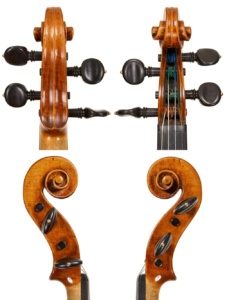
In many ways the current head suits the instrument well. To know that Rembert Wurlitzer believed this to be an original Carlo Bergonzi scroll when he added it in 1950 introduces an important and significant dimension.
In 1952 the newly recapitated Bergonzi was sold to Louis E. Brooks (1880-1958) of Marshall Michigan by Wurlitzer’s salesman, Harry Duffy. Brooks was the heir to an important mail-order catalog business, the Brooks Appliance & Co, which at one time was the world’s preeminent mail-order company. In addition to this Bergonzi, Brooks also owned the 1732 ‘ex Ferni’ Guarneri, the 1718 ‘ex Viotti’ Stradivari, a fine Nicolo Amati ‘ex Wahl’ from 1657 and many fine bows.
The year before Brooks died, he sold this Bergonzi through the Chicago dealer Kenneth Warren & Son to Solomon Efrayim “Fred” Spector (1925-2017). Fred was a member of the Chicago Symphony Orchestra and the owner of this remarkable Bergonzi for sixty years.
The ‘Bennett, Reifenberg, Brooks’ is offered for Private Sale by Tarisio. With serious inquiries, please contact ctome@tarisio.com.
Jason Price is Tarisio’s Founder, Expert and Director. Michael A. Baumgartner has spent many years researching Guarneri del Gesù and the history of his surviving instruments for an upcoming publication.
Notes
[1] Jules Gallay’s catalogs Les Luthiers Italiennes aux XVIIe et XVIIIe Siècles and Les Instrument des Écoles Italiennes from 1869 and 1873 respectively list fifteen distinct Bergonzi violins.
[2] The list of instruments owned by Bennett is truly impressive
[3] Papers re Richard Bennett Collection, Feb-Jul 1902. Papers of A.B. Railton. University of Manchester Library. GB 133 ABR/3.
[4] Nick Pearce, “Gorer v Lever: Edgar Gorer and William Hesketh Lever.” On-Line Catalogue of the Chinese Works of Art in the Lady Lever Art Gallery, https://images.liverpoolmuseums.org.uk/2021-01/gorer_v_lever.pdf (accessed on 14 November 2021).
[5] As a point of comparison, the Hills sold the Lady Blunt Stradivari in 1901 for a near record sum of £1,800.
[6] Perhaps a mis-transcription of a handwritten “Richard”.
[7] Incorrectly reported as Thomas Addie in the August 1961 issue of The Strad and in the catalog to the 2010 exhibition in Cremona.
[8] Gilmer was perhaps infirm at the time of sale as the guarantee to Oddie was signed by his son Charles W. Gilmer per pro his father.
[9] Reifenberg was not the father-in-law of Emanuel Feuermann as reported in the The Strad and in the catalog to the 2010 exhibition but the uncle of Feuermann’s wife.
[10] IThe Jacques Français Business Records, Smithsonian Institution, Box 55, Folder 4, p156.
[11] Rembert Wurltizer inventory records.